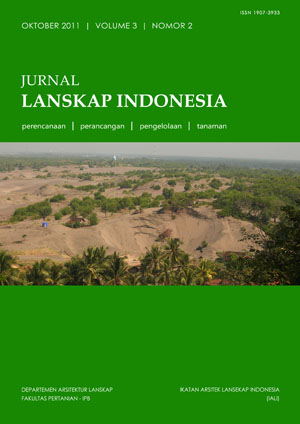INFRASTRUKTUR LIMBAH TERPADU DALAM TAMAN LINGKUNGAN PERMUKIMAN
Abstract
Residential areas are inevitably identified as waste generating region. In general, the waste from the residential area will be transfered from the collecting tool into the garbage carrier at transfer depot which has about 200 m2 area. A residential area of about 10,000 inhabitants requires at least an area of 5,000 m2, generating approximately 25 m3 of waste per day. When transporting all the waste to a landfill, a raise in operating cost and pollution is expected along with odors and garbage scattered along the path. To solve this problem, transfer depot shall be empowered as Integrated Waste Treatment Facility (TPSAT). Transfer depot and neighborhood park is a crucial requirement of a residential area. Integration of both facilities could reduce the negative image of Transfer Depot. TPSAT will produce material that can be recycled, and also organic fertilizer that can be used for maintaining plants growth. While in process of sorting, cleaning, and composting definitely require lots of water. The spacious garden environment can simultaneously be used as a collecting andprocessing area of grey water from surrounding settlements. Waste Water Treatment with Garden (WWG) will produce water that can be used in the process of washing and flushing recycling materials and watering organic fertilizer. Eco-technology tub with 500 m2 area in the depth of 0.8 m ables to generate clean water from greywater at the rate of 100 m3/day generates from 1,000 inhabitant. Park, which is also considered as the lung of environment and communal space, can be integrated and used as local TPSAT WWTP when used with proper layout design and suitable plants.
Downloads
This journal permits and encourages authors to post items submitted to the journal on personal websites or institutional repositories both prior to and after publication, while providing bibliographic details that credit, if applicable, its publication in this journal. However, after the article is submitted and published in this journal, it is fully copyrighted by the Jurnal Lanskap Indonesia or JLI. If excerpts from other copyrighted works are included, the author must obtain written permission from the copyright owner and give credit to the source in the article. Then, the writer or reader is allowed to copy, share, and redistribute articles/material in any form. But it must still include the appropriate source and credit because the article in this journal is licensed by Creative Commons Attribution 4.0 International License (CC BY 4.0).
I. Proposed Policy for Journals That Offer Open Access
Authors who publish with this journal agree to the following terms:
- Authors retain copyright and grant the journal right of first publication with the work simultaneously licensed under a Creative Commons Attribution License that allows others to share the work with an acknowledgement of the work's authorship and initial publication in this journal.
- Authors are able to enter into separate, additional contractual arrangements for the non-exclusive distribution of the journal's published version of the work (e.g., post it to an institutional repository or publish it in a book), with an acknowledgement of its initial publication in this journal.
- Authors are permitted and encouraged to post their work online (e.g., in institutional repositories or on their website) prior to and during the submission process, as it can lead to productive exchanges, as well as earlier and greater citation of published work (See The Effect of Open Access).
II. Proposed Policy for Journals That Offer Delayed Open Access
Authors who publish with this journal agree to the following terms:
- Authors retain copyright and grant the journal right of first publication, with the work after publication simultaneously licensed under a Creative Commons Attribution License that allows others to share the work with an acknowledgement of the work's authorship and initial publication in this journal.
- Authors are able to enter into separate, additional contractual arrangements for the non-exclusive distribution of the journal's published version of the work (e.g., post it to an institutional repository or publish it in a book), with an acknowledgement of its initial publication in this journal.
- Authors are permitted and encouraged to post their work online (e.g., in institutional repositories or on their website) prior to and during the submission process, as it can lead to productive exchanges, as well as earlier and greater citation of published work (See The Effect of Open Access).



























